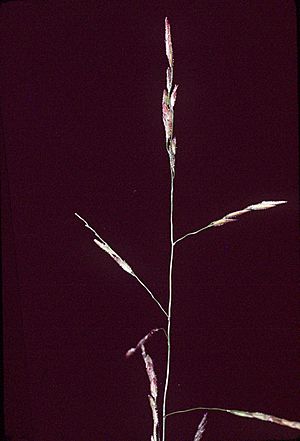Whitegrass facts for kids
Quick facts for kids Whitegrass |
|
|---|---|
 |
|
| Scientific classification | |
| Genus: |
Leersia
|
| Species: |
virginica
|
Leersia virginica, often called whitegrass or white cutgrass, is a type of grass that grows year after year. It is native to eastern North America. You can usually find it in places that are a little wet and partly shaded.
This grass blooms from the middle of summer until early fall.
Contents
What is Whitegrass?
Whitegrass is a common plant in many parts of eastern North America. It's known for growing in damp areas, like along the edges of streams or in wet woodlands. Because it's a perennial plant, its roots stay alive underground through the winter, and the plant grows back each spring.
Where Does Whitegrass Grow?
Whitegrass loves to grow in low-lying areas that are often wet. It prefers spots where it gets some shade, but not full sun all day. This makes it common in forests, swamps, and along the banks of rivers and ponds across its native region.
How to Spot Whitegrass
It can be tricky to tell different types of grasses apart, but whitegrass has some special features. Its leaves have smooth sheaths, which are like the bottom part of the leaf that wraps around the stem. When it blooms, its flower heads have single branches at the very bottom. The tiny parts that hold the seeds, called spikelets, are small and overlap each other quite a bit. Whitegrass also has short underground stems, known as rhizomes, which have scales that overlap.
Whitegrass vs. Rice Cutgrass
Whitegrass is sometimes confused with another grass called rice cutgrass (Leersia oryzoides). But there are clear ways to tell them apart:
- Leaf Sheaths: Whitegrass has smooth leaf sheaths. Rice cutgrass has rougher leaf sheaths that can even feel scratchy.
- Flower Heads: Whitegrass has flower heads with only one branch at the lowest part. Rice cutgrass has flower heads with two or more branches at the lowest part of the stem.
- Spikelets: The spikelets on whitegrass are smaller and overlap a lot. Rice cutgrass has larger spikelets that barely overlap.
- Rhizomes: Whitegrass has short rhizomes with overlapping scales. Rice cutgrass has longer rhizomes, and their scales usually do not overlap.

